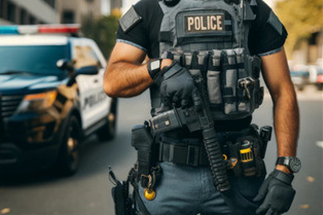26th Apr 2024
Self-Defense Strategies and Equipment for Law Enforcement in a Volatile World
In an era where law enforcement officers encounter increasing threats—from urban crime waves and political unrest to public shootings and potential terrorist activities—the need for comprehensive self-defense tactics and reliable safety equipment is more crucial than ever. The ability of police officers to respond effectively to a variety of volatile situations hinges on their training in diverse self-defense methods and their access to appropriate tools.
Understanding the Risks Confronting Law Enforcement Officers
Every day, law enforcement officers face a spectrum of risks that range from routine interventions to high-stakes emergencies. These situations can escalate quickly, presenting threats not only to the officers but also to the public. Whether it's a traffic stop that turns confrontational or a violent armed encounter, officers must be prepared at all times to protect themselves and others. The unpredictability of these scenarios underscores the importance of both proper preparation and the right defensive tools.
The Critical Role of Self-Defense Tools and Techniques
For law enforcement personnel, an array of self-defense tools and techniques is vital for handling different types of incidents with the appropriate level of force. While a handgun may suffice in some situations, less threatening circumstances might call for non-lethal options like tasers or pepper spray to de-escalate conflicts without causing serious injury. Moreover, skills in martial arts such as Jiu Jitsu can prove indispensable for subduing suspects without resorting to deadly force. Effective communication and negotiation skills are equally important, helping officers defuse potentially volatile situations verbally.
Highlighting Essential Equipment: Body Armor
Among the essential equipment for any police officer is body armor. This protective gear is crucial for safeguarding officers from firearm threats and physical assaults common in encounters with violent criminals or during chaotic events. Modern body armor comes in various forms:
- Soft Body Armor: Typically worn under the uniform, this type offers protection against handgun projectiles and is suitable for daily wear by patrol officers.
- Hard Body Armor Plates: These are designed to withstand rifle rounds and are often used by tactical units in high-risk operations.
The choice between concealable soft armor and more robust tactical vests often depends on the officer’s role and the specific threats they are likely to face.
Popular Types of Body Armor Used by Police Officers
Most police officers wear Level IIIa body armor, a standard set by the National Institute of Justice (NIJ). This level of protection is deemed effective against high-caliber handgun rounds, such as .44 magnums. The proper selection and use of body armor are critical, not only for protection but also for ensuring that officers can move and react quickly in various situations.
Mastering the Use of Self-Defense Tools and Techniques
Equipping officers with the right tools is only part of the solution. Proper training is essential to ensure that officers can use these tools effectively and safely. This training must occur in realistic scenarios that simulate the stress and conditions of actual encounters. Additionally, maintaining this equipment in top condition is paramount to ensure reliability when it's needed most.
Conclusion
In today's complex threat environment, law enforcement officers must be equipped with a broad array of self-defense tools and techniques. From advanced body armor to diverse non-lethal options and combat skills, the range of equipment and knowledge available can significantly impact the outcomes of dangerous encounters. As threats evolve, so too must the strategies and tools at the disposal of those charged with maintaining public safety. These investments in training and equipment are not merely operational necessities but critical components in the mission to protect and serve with confidence and safety.

